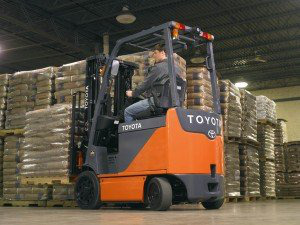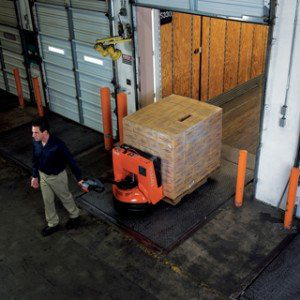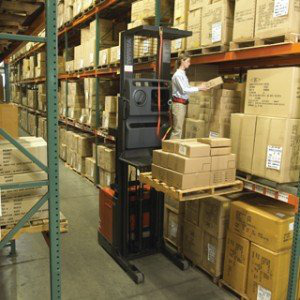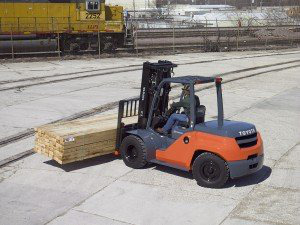Unless you work with forklifts every day, you probably don’t know very much about them. Even those who own or operate forklifts might not be familiar with the full range of options on the market. We’re here to help.
The right truck will fit your work environment and its demands in several key areas. Here are the considerations you need to make when purchasing a lift truck:
- Will it be used indoors, outdoors or both?
- How often do you intend to use the truck?
- What types of materials do you work with, and in what manner?
- How high up do you need to go?
- How narrow are your aisles?
- How heavy/long of a load will it need to lift?
Will it be used indoors, outdoors or both?

The type of truck you’ll want depends on your answers to these questions. If your truck will do its work indoors, you may want to go with a battery-powered forklift. They’re quieter, emission-free and more compact than liquid propane gas (LPG) machines. LPG trucks make more sense in outdoor applications, but they’re also able to operate indoors. Diesel trucks are intended purely for outdoor use.
The indoor/outdoor question also dictates tire type. Forklifts take two different types of tires: cushion and pneumatic. Cushion tires are ideal for indoor use; pneumatic for outdoor. The important thing to know going in is that forklift frames are built specifically for either cushion or pneumatic tires. You can’t change them later.
What type of motor do I need?
Diesel fuel has a long reputation for getting heavy-duty tasks done. But there are fossil fuel emissions from diesel gas that cause global warming and pollution. While diesel is still fairly standard in outdoor use, many companies are providing options to do their part in protecting the planet. The first option is electric motors.
| Motor | Average Cost | Lifespan | Weight it Can Carry | Indoor / Outdoor | Maintenance | Environmental Impact |
|---|---|---|---|---|---|---|
| Electric | $2,500-4,500 | 15-20 years | Varies based on model | Both | Every 6 Months | Better for the environment. They emit fewer greenhouse gasses and air pollutants than petrol or diesel cars. |
| Diesel | $8,000- 9,000 | 30 years | Varies based on model | Outdoor | Every 6 Months | Contributes to the production of ground-level ozone, which damages crops, trees, and other vegetation. Also produced is acid rain, which affects soil, lakes, and streams and enters the human food chain via water, produce, meat, and fish. |
As of now, electric forklifts are considered indoor-use vehicles only and that just shouldn’t be the case. Electric forklifts are well-suited for outdoor environments for tasks such as cross-docking and unloading cargo trucks. Their light weight makes for great maneuverability with impressive lift heights. In addition, electric forklifts don’t emit fossil fuels, which are harmful to workers and the environment, and they’re silent, which has a huge safety benefit when so many machines are running at once, like hearing loss or serious injury.
While there are some tasks better suited for the power of a diesel motor, it is only a matter of time before electric motors will be able to pull the same weight as a diesel motor.

How often do you intend to use the truck?
Some forklift users purchase trucks to use for a couple of hours a day, while others run them nonstop. If you’re seeking something for occasional use, you might consider a walk-behind (or “walkie”) forklift, as they’re more cost-effective. In that regard, used equipment is a fine option as well. Things to consider when choosing the right used forklift include applications and the number of hours needed. Those operating forklift trucks on a high cycle will want to invest a few more dollars in customization. Important considerations include attachments such as side-shifting fork positioners and ergonomic features for operator comfort and safety.
Used vs. New Forklift
When it comes to choosing between used and new forklifts, it really comes down to use. A used forklift is recommended if you are doing small jobs that don’t exceed 4 hours a day. Additional use will only cause your used forklift to require maintenance sooner, making it a costly investment. At that point, purchasing a new forklift is recommended.

What types of materials do you work with, and in what manner?
The types of materials you’re working with will translate to equipment choice in several ways. First, it will affect how you choose to warehouse inventory. In other cases, it won’t necessarily be your materials, but what you do with them (like how you assemble orders) that dictates the ideal truck. So, for certain industries, a reach truck or an order picker might be the best fit for your application. Some types of trucks are optimized to handle specific materials, like lumber or metal; others are designed for cold storage applications.
How high up do you need to go?
Your warehousing will also dictate how high the forks need to reach. This will assist you in determining which type of mast you require.
How narrow are your aisles?
The aisle width will help you decide whether you should choose sit-down or stand-up rider trucks, and whether to opt for three- or four-wheel equipment.

How heavy/long of a load will it need to lift?
The weight of your materials will guide the decision regarding what size truck you need. The heavier the materials, the larger the truck required to lift them. Larger trucks are, of course, less maneuverable — they’re also more expensive, so it’s important to find the right balance. The load length of your materials is also a deciding factor. Longer loads may require longer forks but will also affect the truck’s lift capacity. So, longer loads will necessitate more powerful trucks than shorter loads of the same weight.
The average load for forklifts varies based on the model, but forklift trucks can carry from 3,000 up to 70,000 pounds based on their weight capacity. These trucks help move brick pallets, steel joists, and wood and steel beams.
What type of terrain will I encounter?
Depending on the model, there are forklifts meant specifically for warehouse needs, but rough terrain forklift trucks are designed to operate on rough, natural terrain, unpaved surfaces, and disturbed or dug-up surfaces. At first glance, you’ll notice how the tires on a rough terrain forklift differ from those on an indoor lift. They are grooved to maneuver around the unstable, hilly, rocky terrain and keep moving past obstacles.
So which model is best for my needs?
Our forklift finder tool can help you determine which model is best for your application.
There are myriad interrelated factors to consider when investing in a lift truck. Hopefully, this article answers some questions, and we’ll delve more into the specifics every month. On the bright side, our veteran sales team will guide you every step of the way. Contact us to learn more about forklift types and classifications.
